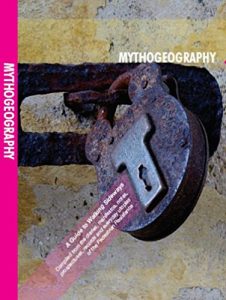NB: The eversion doesn't have any of the hundreds of colour images and other design features that the printed book has.
At its simplest, this is a book about walking: the funny and touching account of the author's walk across the heart of the English countryside in the footsteps of Edwardian oak tree planter Charles Hurst. What Phil Smith found was a countryside littered with beer cans and 100 years of change, punctured by cars and populated by an extraordinary cast, each with a story to tell about their connection to the places they call home. But Phil Smith is no ordinary walker. Consistently one of Europe's most exciting and innovative performance artists, he has made 'walking sideways' into an art. Later in the book, his 'handbook of drifting', 'tool bag of actions' and 'the orrery' offer a whirlwind of ideas on how to walk like a stalker, a swimmer, a ghost, an explorer, a pilgrim...As he says: Mythogeography is a way of walking, thinking and organising on many levels at the same time. Anyone can do it. You can do it...By setting ourselves in motion through a world of images we make ourselves human movie cameras or camera phones - both interpreters and producers. By the particular focuses and the angles of trajectory we choose, we make an interpretation of our world, and from our impressions we begin to re-make its meanings. The productions that follow from these experiences - a conversation in a bar, a procession, a conspiracy, a plan, a map, an organisation, a gesture - are what mythogeography is. At another level, "Mythogeography" celebrates a loose weave of artists, teachers, activists and walkers whose practices have, in the last decade, taken up where psychogeography left off and started to bring together a range of disciplines and activisms including site-specific artists and performers, urbanists, derivistes, philosophers, drifters, geographers, anthropologists, film-makers and sociologists. On this plane, "Mythogeography" is a handbook for tripping up the ordinary. As the author says: Drawing on a history of Dadaist deambulation, situationist derive, dematerialised land art, mad-dog marketeering and activist intervention, it weaves between totalising utopias and defeatism, while skulking in holy places, trading under fake colours and planning its next false flag operations. It provides a series of theoretical investigations into the underpinnings of resistant walking - in myth, in cellular and spiral organisation, in the dematerialisation of sculpture and the 'tight organisation' of the drift. All this in the guise of a mystery about walkers. Deceitful and hopeful, this is the first manifesto of a new kind of everyday: Walking 4.0. In short, walking isn't what it used to be. It's been deconstructed, theorised, analysed, performed, philosophised, disgraced and reinvented. This is a book about what walking has become.
At its simplest, this is a book about walking: the funny and touching account of the author's walk across the heart of the English countryside in the footsteps of Edwardian oak tree planter Charles Hurst. What Phil Smith found was a countryside littered with beer cans and 100 years of change, punctured by cars and populated by an extraordinary cast, each with a story to tell about their connection to the places they call home. But Phil Smith is no ordinary walker. Consistently one of Europe's most exciting and innovative performance artists, he has made 'walking sideways' into an art. Later in the book, his 'handbook of drifting', 'tool bag of actions' and 'the orrery' offer a whirlwind of ideas on how to walk like a stalker, a swimmer, a ghost, an explorer, a pilgrim...As he says: Mythogeography is a way of walking, thinking and organising on many levels at the same time. Anyone can do it. You can do it...By setting ourselves in motion through a world of images we make ourselves human movie cameras or camera phones - both interpreters and producers. By the particular focuses and the angles of trajectory we choose, we make an interpretation of our world, and from our impressions we begin to re-make its meanings. The productions that follow from these experiences - a conversation in a bar, a procession, a conspiracy, a plan, a map, an organisation, a gesture - are what mythogeography is. At another level, "Mythogeography" celebrates a loose weave of artists, teachers, activists and walkers whose practices have, in the last decade, taken up where psychogeography left off and started to bring together a range of disciplines and activisms including site-specific artists and performers, urbanists, derivistes, philosophers, drifters, geographers, anthropologists, film-makers and sociologists. On this plane, "Mythogeography" is a handbook for tripping up the ordinary. As the author says: Drawing on a history of Dadaist deambulation, situationist derive, dematerialised land art, mad-dog marketeering and activist intervention, it weaves between totalising utopias and defeatism, while skulking in holy places, trading under fake colours and planning its next false flag operations. It provides a series of theoretical investigations into the underpinnings of resistant walking - in myth, in cellular and spiral organisation, in the dematerialisation of sculpture and the 'tight organisation' of the drift. All this in the guise of a mystery about walkers. Deceitful and hopeful, this is the first manifesto of a new kind of everyday: Walking 4.0. In short, walking isn't what it used to be. It's been deconstructed, theorised, analysed, performed, philosophised, disgraced and reinvented. This is a book about what walking has become.






